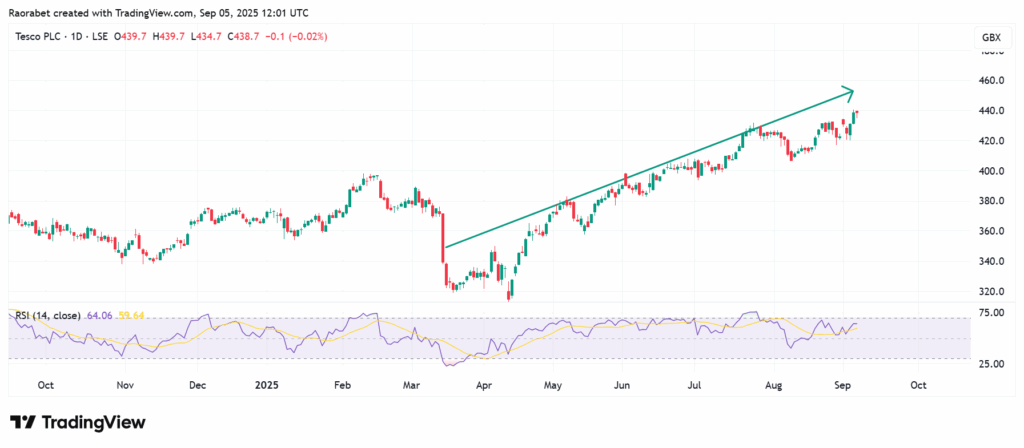- Lloyds share price has risen by nearly 50% year-to-date, but the next few months could present a whole new set of challenges.
Lloyds Banking Group stock price (LON:LLOY) has signaled a degree of volatility since late August, and recent action has seen it lose a a portion of the gains registered following a great performance earlier in 2025. Investors have in recent days grown uncertain about the stock’s short-term future.
Also, there’s the big question as to whether it can hit the psychological £1 level after a 47% year-to-date rise. A look at the company’s fundamentals, technical signals, and the UK economy as a whole, reveals how complex things are.
An Analysis of Recent Pullback
Since the end of August, Lloyds shares have been under a lot of pressure. The stock had a 52-week high of about 84.6p, but then it started to decline and fell to the 79–81p range. Even though this drop was substantial, it should be seen in light of the stock’s strong gains since the start of the year. The pullback was mostly caused by reports of probable political dangers, such as concerns about a possible windfall tax on UK banks, which caused the broader industry to go down.

Tesco stock price action on the daily chart showing strong gains since mid-March
The stock has dropped roughly 3% from its highs in late August, which is a little larger than the FTSE 100 during that time. Notably, however, the stock has gone up 39.68% in the last year and 199.09% in the last five years, showing that it can handle high interest rates.
Recent news, such plans to lay off personnel who are underperforming and outsource some jobs to India, has created a negative sentiment among some investors. The media has focused on the threats to morale but there could be possible gains in profits.
The Fundamentals Demonstrate Strong Baseline
The fundamentals of Lloyds are still strong, which supports its valuation despite the recent stock price decline. The company’s most recent annual revenues came in at £17.67 billion, its net income is £4.05 billion, and its profit margin is 25.61%.EPS is 0.07p. These translates to a trailing P/E of 11.48 and a forward P/E of 8.80. This denotes that the stock is undervalued compared to its growth potential. Analysts predict earnings to grow by 11.8% per year and revenue to expand by 6.4%, with EPS expected to climb by 15.8% each year.
Despite the glossy picture, there are a few concerns that are coming up. The likelihood of a windfall tax on UK banks is a major one, since it could hurt their profits. Also, the Financial Conduct Authority (FCA) is currently looking into the ongoing motor financing mis-selling case, and even though the Supreme Court ruled in favor of the FCA, there is still a chance of a costly redress plan.
Furthermore, the UK’s economic future is also still unclear. Lloyds is a major player in the UK mortgage market as a domestic lender. If the property market slows down significantly or consumer spending drops, it might put pressure on loan growth and asset quality.
Momentum Indicators Signal Confidence
Technicals paint a mixed picture: long-term trends on Lloyds share price are optimistic, but short-term trends imply weakness. While the stock price is currently below its recent highs, it is still floating above important support levels. There isn’t a lot of particular moving average data, but the 52-week high of 84.62p shows that the 50-day SMA around 80-82p has been challenged. The 200-day SMA is probably near 70p, which would provide floor support.
The lower Bollinger Band break on August 29, signals that oversold equities could bounce back. The RSI is thought to be between 40 and 50, which is neutral but not oversold, so it doesn’t go to extremes. MACD is showing convergence, and recent crosses signal that bearish momentum is receding.
What Are the Odds of Lloyds Share Price Hitting £1?
There is a significant level of disagreement about whether Lloyds’ shares will touch £1 soon. Bullish analysts have an average 12-month price target of 89–91p, which means that the stock could rise up 10–13% from 80p. In the best-case outlook, including high interest rates staying high, restructuring saving money, and EPS growth, the chances of attaining 100p in 12 to 18 months are still less than 50%. But there are also extremely bullish targets that go up to 103p, and one that goes up to 115p, which means that if profits meet expectations, Lloyds stock price could go up to £1 (100p).
That being said, the prevailing opinion is that these conditions are not likely to happen in the near future. The Bank of England’s planned interest rate cut could help the economy as a whole, but they could also hurt Lloyds’ net interest margin (NIM), which is a fundamental measure of how profitable a bank is.
Since the end of August, Lloyds’ stock price has fallen from its 52-week high. It has experienced increased volatility on increased fundamental concerns including the possibility of a UK windfall tax on banks.
Some of the greatest risks are the possibility of a windfall tax, the results of the FCA inquiry into the mis-selling of car loans, and the UK’s uncertain economic future.
Analysts project that the chances are slim in the short term because the economy needs to bounce back fast and regulatory problems need to be solved.
This article was originally published on InvestingCube.com. Republishing without permission is prohibited.


